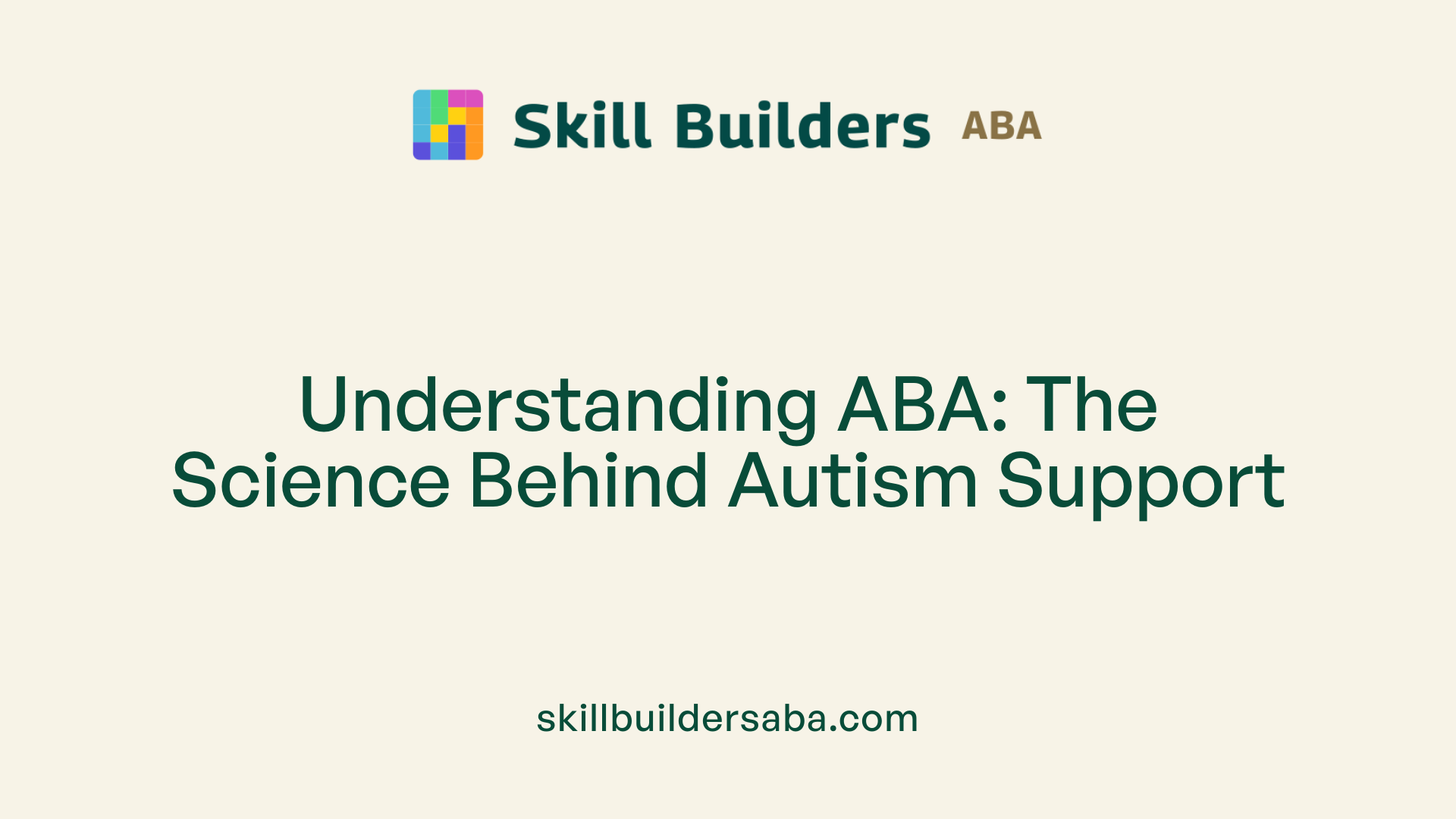
Understanding behavior momentum in ABA
The Power of Behavioral Momentum in Transforming Autism Therapy
Exploring a Dynamic Strategy within Applied Behavior Analysis
Applied Behavior Analysis (ABA) therapy has long been recognized as a scientifically validated method for supporting individuals on the autism spectrum. Within this framework, the concept of behavioral momentum is emerging as a key strategy to promote compliance, skill acquisition, and overall engagement. This article delves into what behavioral momentum entails, its application in ABA, and the ways it benefits children with autism and their families.
Foundations of ABA Therapy in Autism Treatment

What is applied behavior analysis (ABA) therapy in the context of autism treatment?
Applied Behavior Analysis (ABA) therapy is a scientifically validated approach designed to assist individuals with autism spectrum disorder (ASD) by improving essential skills and reducing challenging behaviors. It is rooted in learning principles and behavioral science, emphasizing measurable and observable behaviors.
Definition and principles of ABA therapy
ABA therapy functions by carefully analyzing the relationship between antecedents (what happens before a behavior), behaviors themselves, and consequences (what happens after) — known as the ABC framework. Therapists use this framework to understand why behaviors occur and how to encourage positive changes. The therapy involves personalized programs tailored to the individual's needs, goals, and strengths.
Role of positive reinforcement and ABC framework
A crucial element in ABA is positive reinforcement, where desired behaviors are followed by rewards or praise, increasing the likelihood that these behaviors will recur. By strategically applying this technique, ABA fosters gradual improvement and skill mastery. The ABC model enables therapists to evaluate behaviors precisely and develop targeted interventions.
Skill acquisition and behavior modification in autism
ABA therapy aids children with autism in acquiring vital social skills, enhancing communication, and adapting daily routines. It employs both structured sessions and natural environment training to build skills that generalize to everyday life. Progress is tracked through consistent data collection, allowing adjustments to treatment plans. This systematic approach supports improvements in communication, social interaction, and adaptive functioning, contributing to better outcomes for individuals on the spectrum.
Behavioral Momentum: Building Compliance Through Successive Requests

What is Behavioral Momentum? How Does the Snowball Analogy Illustrate It?
Behavioral momentum in ABA therapy is a strategy that starts by giving a child simple, easy-to-follow requests known as high-probability (HP) requests. These are tasks the child is likely to complete successfully. This approach is like a snowball rolling downhill — with each success, momentum builds, making it easier to progress to more challenging tasks.
What are High-Probability (HP) and Low-Probability (LP) Requests in ABA?
HP requests are activities or commands the child readily complies with due to their simplicity or preference. In contrast, low-probability (LP) requests are more difficult or less preferred tasks. Behavioral momentum builds by leading with HP requests to boost compliance, then smoothly transitioning to LP requests.
How Does Behavioral Momentum Enhance Task Compliance?
By steadily increasing task difficulty, behavioral momentum promotes confidence and cooperation. Starting with easier requests builds a positive rhythm, making the child more willing to engage with harder tasks. This break-down into manageable steps helps the child adapt and sustain engagement.
What is the Role of Positive Reinforcement?
Positive reinforcement is crucial in maintaining momentum. Praising or rewarding successful responses encourages the child to repeat desired behaviors. This continuous cycle of success and reinforcement makes it more likely the child will comply with future requests and generalize these behaviors across different settings.
Overall, behavioral momentum in ABA therapy leverages a structured sequence of demands paired with reinforcement to increase compliance and build lasting skills.
Practical Implementation and Benefits of Behavioral Momentum in ABA

Strategies for identifying and sequencing requests
Behavioral momentum in ABA therapy begins by selecting high-probability (HP) requests—simple tasks the child is likely to comply with. These preferred activities create a positive momentum before gradually introducing low-probability (LP) requests, which are more challenging or less preferred tasks. Practitioners deliver these requests in rapid succession, maintaining momentum through clear instructions and consistent positive reinforcement. This sequence increases the chances of compliance when transitioning to difficult behaviors.
Examples of gradual task difficulty increase
For instance, a therapist might first engage a child with favorite activities (HP requests) such as sorting colorful blocks or simple matching games. Following this, the session may gradually shift to more complex multi-step instructions or introduce less preferred activities like trying new foods during mealtime, always ensuring tasks remain achievable for the child. This approach mirrors the analogy of a snowball rolling downhill, gathering speed as successful responses accumulate.
Benefits such as increased motivation, confidence, and generalization
This method enhances motivation by promoting confidence through repeated success. It increases cooperation and engagement, reduces challenging behaviors, and supports better generalization of skills across different settings. Children build adaptive skills and improve social interactions by experiencing success in manageable steps linked with reinforcement.
Challenges faced during implementation and solutions
However, implementation challenges include maintaining consistency and selecting appropriate incentives tailored to the child's preferences. These challenges require close collaboration between caregivers and professionals, thorough data collection, and ongoing monitoring to adjust goals and reinforcement strategies. Supporting parents through training and coaching ensures greater consistency and effectiveness in daily routines.
| Aspect | Description | Impact on Therapy |
|---|---|---|
| Request sequencing | Start with HP requests, then LP requests | Builds momentum and increases compliance |
| Gradual difficulty | Shift from easy to more complex tasks | Promotes confidence and skill-building |
| Positive reinforcement | Immediate praise or reward after compliance | Encourages repetition of desired behaviors |
| Collaboration and data | Caregiver-professional teamwork and progress monitoring | Addresses challenges and customizes interventions |
| Parent involvement | Training and coaching parents | Ensures consistency and empowers support at home |
The Collaborative Team Behind ABA Therapy Delivery

Who are the professionals involved in delivering ABA therapy?
ABA therapy is delivered by a coordinated team of trained professionals. The primary clinical leaders are Board Certified Behavior Analysts (BCBAs). They design, supervise, and modify individualized treatment plans based on thorough functional behavior assessments. BCBAs usually hold master's degrees and meet strict certification criteria.
Supporting BCBAs are Registered Behavior Technicians (RBTs) and Board Certified Assistant Behavior Analysts (BCaBAs). RBTs are trained and certified to implement ABA interventions directly with clients under BCBA supervision. BCaBAs assist with therapy delivery and data collection while working toward full BCBA certification.
Importance of parent training and support
Parent involvement is a cornerstone of effective ABA therapy. Parent training programs empower caregivers with skills to support behavior management and social skill development in the home and community. This collaborative approach extends therapy beyond clinical sessions and increases generalization of learned behaviors.
Settings for therapy: in-home, center-based, virtual
ABA therapy is provided in multiple settings to accommodate individual needs. Services can be delivered in-home, helping children learn in familiar environments; center-based clinics offering structured therapy sessions; or via virtual platforms to increase accessibility and continuity of care.
Use of functional behavior assessments and intervention plans
Conducting functional behavior assessments is essential to identify the reasons behind challenging behaviors. These assessments inform the creation of targeted behavior intervention plans. Such plans use evidence-based strategies to modify behaviors and promote positive skill acquisition.
This multidisciplinary and collaborative team approach ensures that ABA therapy is personalized, consistent, and effective across environments.
Measuring the Effectiveness of ABA and Behavioral Momentum Strategies

How is the effectiveness of ABA therapy measured?
The effectiveness of ABA therapy is primarily gauged through continuous data collection on the individual's progress across targeted skills and behavioral outcomes. This process involves regular monitoring and review by the therapy team, who adjust goals and intervention strategies based on the data collected. Quantitative measures such as mastery of specific skills are combined with qualitative feedback from parents and educators, highlighting improvements in communication and reductions in challenging behaviors.
Data collection and progress monitoring
Effective ABA programs utilize systematic data recording methods to track skill acquisition and behavior change. Examples include session notes, frequency counts of target behaviors, and performance accuracy. This enables objective evaluation of progress and informs necessary modifications to the therapy plan. Data is collected consistently to maintain momentum and ensure interventions remain tailored to the individual's evolving needs.
Outcome measures related to skill mastery and behavior change
Outcomes typically assessed include language development, social skills, adaptive functioning, and reduction in maladaptive behaviors. Mastery of specific goals signals progress, while decreased frequency or intensity of problem behaviors confirms behavioral improvements. Parent and caregiver reports further support these assessments, offering insight into changes in daily life and social interactions.
Evidence supporting early and intensive intervention
Research supports that early intervention and higher treatment intensity—measured in hours per week and duration—correlate with stronger outcomes in children with autism. Early and comprehensive support leads to better communication, social engagement, and adaptive behavior, underscoring the importance of beginning ABA therapy promptly and maintaining consistent sessions.
How momentum strategies contribute to positive outcomes
Behavioral momentum techniques, which begin with simple, high-probability requests to build compliance momentum, contribute significantly to positive therapy outcomes. These strategies foster cooperation, confidence, and a smoother transition to challenging tasks. The analogy of a snowball gaining speed illustrates how successive successful responses increase motivation and adherence. Combined with reinforcement and prompting, behavioral momentum promotes generalized skill application across settings, resulting in improved social and adaptive skills.
| Aspect | Description | Importance in Measuring Effectiveness |
|---|---|---|
| Data Collection | Systematic tracking of responses, skill mastery, and behavior frequency | Enables objective progress evaluation and therapy adjustments |
| Outcome Measures | Mastery of goals, behavior reduction, social and adaptive skill increments | Reflect therapy gains and real-life functional improvements |
| Early Intensive Intervention | Higher treatment hours and early start linked to superior developmental outcomes | Critical for maximizing treatment potential |
| Behavioral Momentum | Use of high-probability requests to build compliance and confidence leading to engagement | Enhances motivation & cooperation, supporting sustained progress |
Harnessing Behavioral Momentum to Enhance ABA Therapy Outcomes
Behavioral momentum represents a powerful, evidence-based strategy within Applied Behavior Analysis that supports children with autism by fostering compliance through a structured sequence of manageable tasks. By leveraging high-probability requests and positive reinforcement, this approach builds confidence, motivation, and cooperation, helping individuals generalize skills across environments. Successful implementation requires collaboration among skilled professionals and engaged families, underscoring the comprehensive nature of ABA therapy. Ongoing measurement of progress ensures these strategies adapt to each individual's needs, ultimately promoting meaningful improvements in social interaction, communication, and everyday functioning.
References
- ABA Therapy | Empowering Positive Behavioral Change Daily
- Behavioral Momentum in ABA Therapy: The Power ...
- Success with Behavioral Momentum in ABA for Autism
- Behavioral Momentum Services
- Behavior Momentum (ABA) For Families
- An evaluation of the effects of intensity and duration on ...
- What Does the Research Say About ABA Therapy's ...
- The Effectiveness of Applied Behavior Analysis
- Applied Behavior Analysis (ABA)
Get the Support You Need to Move Forward
If you're exploring therapy options and want a clearer picture of what makes sense for your child, you can take a moment to review our main overview on our website. And if you prefer direct, personalized guidance, you can contact us to speak with someone from our team.
Reach Out Today
Learn more about how we can support your child’s growth and development. Contact us to discuss our services and availability in your area.
.svg)